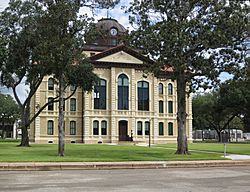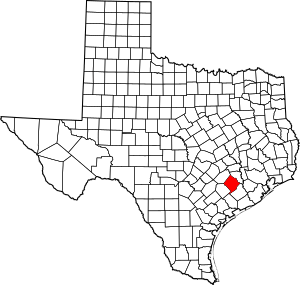Colorado County, Texas facts for kids
Quick facts for kids
Colorado County
|
|
|---|---|

Colorado County Courthouse in Columbus. Built 1890-1891: this 2014 photo shows restoration to original color scheme made in 2013
|
|

Location within the U.S. state of Texas
|
|
 Texas's location within the U.S. |
|
| Country | |
| State | |
| Founded | 1837 |
| Named for | Colorado River |
| Seat | Columbus |
| Largest city | Columbus |
| Area | |
| • Total | 974 sq mi (2,520 km2) |
| • Land | 960 sq mi (2,500 km2) |
| • Water | 13 sq mi (30 km2) 1.4% |
| Population
(2020)
|
|
| • Total | 20,557 |
| • Density | 21.106/sq mi (8.149/km2) |
| Time zone | UTC−6 (Central) |
| • Summer (DST) | UTC−5 (CDT) |
| Congressional district | 10th |
Colorado County is a county located in the U.S. state of Texas. As of the 2020 census, its population was 20,557. Its county seat is Columbus. It is named for the Colorado River of Texas. The county was founded in 1836 and organized the next year.
Contents
History
The territory that is now Colorado County has been continually inhabited by humans for at least 12,000 years. The Coco branch of the Karaknawa are said to have hunted in the area, while Tonkawa crossed the area from the south.

The first record of a European coming through the area that is now Colorado County was January 20, 1687, when René Robert Cavelier, Sieur de La Salle, camped along Skull Creek. The party located an Indian village and named it Hebemes. The fourth expedition of Alonso De León may have crossed into the area while looking for Fort St. Louis in 1689.
The area was settled by Anglo colonists who were part of Stephen F. Austin's Old Three Hundred starting in 1821. Some families settled near Beeson's Ford, a few miles south of Columbus' present day location. The area was active during the days of the Texas Revolution. Dilue Rose Harris wrote her memoir of the Runaway Scrape from within the boundaries of Colorado County.
The county was one of the original Republic of Texas counties when it formed in 1836. Following the American Civil War, the county had one of the larger populations of African-American freedmen in the state, and was granted a Freedmen's Bureau office in Columbus.
Many European settlers, particularly Germans, as well as Moravians and Bohemians from what became Czechoslovakia, began to settle in the county after the Civil War, although Germans had settled in the area as early as 1830.
Geography
According to the U.S. Census Bureau, the county has a total area of 974 sq mi (2,520 km2), of which 13 sq mi (34 km2) (1.4%) are covered by water.
Major highways
 Interstate 10
Interstate 10 U.S. Highway 90
U.S. Highway 90
 U.S. Highway 90 Alternate
U.S. Highway 90 Alternate State Highway 71
State Highway 71
Adjacent counties
- Austin County (northeast)
- Wharton County (southeast)
- Jackson County (south)
- Lavaca County (southwest)
- Fayette County (northwest)
National protected area
Demographics
| Historical population | |||
|---|---|---|---|
| Census | Pop. | %± | |
| 1850 | 2,257 | — | |
| 1860 | 7,885 | 249.4% | |
| 1870 | 8,326 | 5.6% | |
| 1880 | 16,673 | 100.3% | |
| 1890 | 19,512 | 17.0% | |
| 1900 | 22,203 | 13.8% | |
| 1910 | 18,897 | −14.9% | |
| 1920 | 19,013 | 0.6% | |
| 1930 | 19,129 | 0.6% | |
| 1940 | 17,812 | −6.9% | |
| 1950 | 17,576 | −1.3% | |
| 1960 | 18,463 | 5.0% | |
| 1970 | 17,638 | −4.5% | |
| 1980 | 18,823 | 6.7% | |
| 1990 | 18,383 | −2.3% | |
| 2000 | 20,390 | 10.9% | |
| 2010 | 20,874 | 2.4% | |
| 2020 | 20,557 | −1.5% | |
| U.S. Decennial Census 1850–2010 2010 2020 |
|||
| Race / Ethnicity (NH = Non-Hispanic) | Pop 2000 | Pop 2010 | Pop 2020 | % 2000 | % 2010 | % 2020 |
|---|---|---|---|---|---|---|
| White alone (NH) | 13,165 | 12,496 | 11,761 | 64.57% | 59.86% | 57.21% |
| Black or African American alone (NH) | 2,962 | 2,636 | 2,222 | 14.53% | 12.63% | 10.81% |
| Native American or Alaska Native alone (NH) | 40 | 24 | 13 | 0.20% | 0.11% | 0.06% |
| Asian alone (NH) | 42 | 75 | 80 | 0.21% | 0.36% | 0.39% |
| Pacific Islander alone (NH) | 3 | 15 | 0 | 0.01% | 0.07% | 0.00% |
| Other race alone (NH) | 0 | 25 | 41 | 0.00% | 0.12% | 0.20% |
| Mixed Race or Multiracial (NH) | 154 | 151 | 450 | 0.76% | 0.72% | 2.19% |
| Hispanic or Latino (any race) | 4,024 | 5,452 | 5,990 | 19.74% | 26.12% | 29.14% |
| Total | 20,390 | 20,874 | 20,557 | 100.00% | 100.00% | 100.00% |
As of the census of 2000, 20,390 people, 7,641 households, and 5,402 families were residing in the county. The population density was 21 people/sq mi (8.1 people/km2). The 9,431 housing units averaged 10 per square mile (3.9/km2). The racial makeup of the county was 72.79% White, 14.80% African American, 0.37% Native American, 0.21% Asian, 10.06% from other races, and 1.78% from two or more races. About 19.74% of the population were Hispanics or Latinos of any race.
Of the 7,641 households, 31.1% had children under 18 living with them, 56.3% were married couples living together, 10.9% had a female householder with no husband present, and 29.3% were not families. About 26.2% of all households were made up of individuals, and 14.4% had someone living alone who was 65 or older. The average household size was 2.56, and the average family size was 3.08.
In the county, the age distribution was 25.6% under 18, 8.9% from 18 to 24, 23.8% from 25 to 44, 23.1% from 45 to 64, and % who were 65 or older. The median age was 39 years. For every 100 females, there were 95.30 males. For every 100 females age 18 and over, there were 92.40 males.
The median income for a household in the county was $32,425, and for a family was $41,388. Males had a median income of $30,063 versus $20,014 for females. The per capita income for the county was $16,910. About 12.3% of families and 16.2% of the population were below the poverty line, including 21.0% of those under age 18 and 15.80% of those age 65 or over.
Communities
Cities
Census-designated place
Unincorporated communities
Ghost towns
- Lakeside
- Matthews
- New Bielau
- Osage
- Pisek
- Provident City
- Ramsey
See also
 In Spanish: Condado de Colorado para niños
In Spanish: Condado de Colorado para niños

